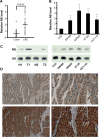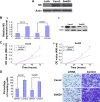Upregulation of nucleostemin in colorectal cancer and its effects on cell malignancy
- PMID: 26229488
- PMCID: PMC4516200
- DOI: 10.2147/OTT.S78461
Upregulation of nucleostemin in colorectal cancer and its effects on cell malignancy
Retraction in
-
Upregulation of nucleostemin in colorectal cancer and its effects on cell malignancy [Retraction].Onco Targets Ther. 2016 May 5;9:2625. doi: 10.2147/OTT.S111824. eCollection 2016. Onco Targets Ther. 2016. PMID: 27226724 Free PMC article.
Abstract
Objective: Nucleostemin (NS) is a new protein localized in the nucleolus of most stem cells and tumor cells, which regulates their self-renewal and cell cycle progression. The aim of this study was to investigate the expression of NS in colorectal cancer (CRC) and the effects of NS knockdown in the Sw620 cell line to provide basis for clinical target therapy.
Methods: NS expression in 372 patients with CRC and 367 normal participants was assessed using immunohistochemistry. The expression level of NS gene was evaluated by polymerase chain reaction. Then, the relationship among NS expression, clinicopathological features, and prognosis was analyzed. Silencing of NS expression was achieved by using NS-specific small-interfering RNAs. The viability and growth rate of Sw620 cells were determined by proliferation and invasion assays. Cell cycle distribution of the cells was analyzed by flow cytometry.
Results: High NS expression was positively related with node metastasis, distant metastasis, and TNM stage. In Kaplan-Meier survival analysis, patients with low NS expression always had significantly longer survival time than those with high expression. Moreover, our results showed that knockdown of NS expression inhibited proliferation and viability of Sw620 cells in a time-dependent manner. Cell cycle studies revealed that NS depletion resulted in G1 cell cycle arrest at short times of transfection (24 hours), followed with apoptosis at longer times (48 hours and 72 hours), suggesting that post-G1 arrest apoptosis occurred in Sw620 cells.
Conclusion: Overall, these results point to the essential role of NS in Sw620 cells; thus, this gene might be considered a promising target for treatment of CRC.
Keywords: Sw620; apoptosis; colorectal cancer; nucleostemin; small interfering RNA; target therapy.
Figures





Similar articles
-
Nucleostemin regulates proliferation and migration of gastric cancer and correlates with its malignancy.Int J Clin Exp Med. 2015 Oct 15;8(10):17634-43. eCollection 2015. Int J Clin Exp Med. 2015. Retraction in: Int J Clin Exp Med. 2017 Nov 15;10(11):15800. PMID: 26770353 Free PMC article. Retracted.
-
Nucleostemin depletion induces post-g1 arrest apoptosis in chronic myelogenous leukemia k562 cells.Adv Pharm Bull. 2014;4(1):55-60. doi: 10.5681/apb.2014.009. Epub 2013 Dec 23. Adv Pharm Bull. 2014. PMID: 24409410 Free PMC article.
-
High expression of fibronectin is associated with poor prognosis, cell proliferation and malignancy via the NF-κB/p53-apoptosis signaling pathway in colorectal cancer.Oncol Rep. 2016 Dec;36(6):3145-3153. doi: 10.3892/or.2016.5177. Epub 2016 Oct 17. Oncol Rep. 2016. PMID: 27748871 Free PMC article.
-
Nucleostemin knocking-down causes cell cycle arrest and apoptosis in human T-cell acute lymphoblastic leukemia MOLT-4 cells via p53 and p21Waf1/Cip1 up-regulation.Hematology. 2014 Dec;19(8):455-62. doi: 10.1179/1607845414Y.0000000153. Epub 2014 Mar 17. Hematology. 2014. PMID: 24628257
-
Long non-coding RNA FOXP4-AS1 is an unfavourable prognostic factor and regulates proliferation and apoptosis in colorectal cancer.Cell Prolif. 2017 Feb;50(1):e12312. doi: 10.1111/cpr.12312. Epub 2016 Oct 27. Cell Prolif. 2017. PMID: 27790757 Free PMC article.
References
Publication types
LinkOut - more resources
Full Text Sources
Miscellaneous

